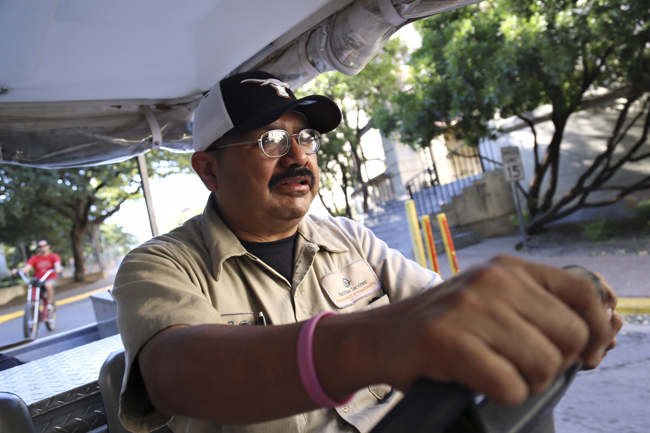It’s 3 p.m., and Robert Soto is just beginning his day as building controls technician.
As the rest of the University starts to close down, Soto gathers supplies for his shift — a clipboard overflowing with work order requests, a white bucket filled with tools, a walkie-talkie so people at the office can contact him — and loads it all into his University-issued golf cart.
He gets into the cart and drives across campus to begin his 3-11 p.m. shift.
“I love it because the campus is closed, and I’m here, and I’ve got full reins of everything,” Soto said later in the night while fixing one of the University’s many thermostats.
Soto, who has worked at the University for 28 years, is one of UT’s seven second-shift workers. These employees stay late and work behind the scenes to keep UT facilities running smoothly. The seven workers specialize in various fields and do everything from turning off fire alarms — the most common reason for nighttime calls — to adjusting thermostats, fixing sprinkler systems, fishing keys out of drains, doing plumbing work and even repairing damage to buildings.
“This place never shuts down,” Soto said. “It’s a 24-hour operation. Even when the gates are closed, there’s stuff going on everywhere.”
Several of the second-shift workers, including Soto, serve as one of the University’s 11 on-call workers, said Zach Adcock, manager of facilities maintenance. These staff members are called in from home for emergencies after second-shift hours.
“If we just use our emergency on call, it can take 30 minutes or more for them to get here, and, by that time, the class is almost over,” Adcock said. “Whereas if we have someone on site, we can go and try to get that classroom relit or address those hot and cold issues at least while they’re still in class.”
Each worker’s night starts out in the building operation center: a room in the Facilities Complex Building 3 that is covered in screens that show the facility systems of University buildings. From the room, operators can see when alarms go off and the temperature of each building.
The operators can control many of the buildings’ settings, but issues that cannot be controlled must be handled by maintenance personnel, such as Soto. The operators call the workers to assign tasks on top of their already assigned work orders and routine maintenance.
“I’ve got enough calls to last me all night,” Soto said.
According to Adcock, Facilities Services receives about 80,000 work orders a year. This includes called-in and preventive maintenance. He said around 150 day workers do 80 percent of the work, leaving the rest for night staff.
Thomas Crawford, building operations crew leader, said that while the workers have areas of expertise, they can often solve problems outside their field.
“We just try and help out, and sometimes there are some crazy calls that aren’t really defined by someone’s job. But, hey, we’re here,” Crawford said. “We’ll help you out.”
Driving around campus, people stopped to greet Soto at almost every turn. Until recently, Soto had been working the day shift and got to know faculty and staff members all over campus.
Working the evening shift provides more freedom and adds variety to the job, Soto said.
“I’ve seen and done everything, so nothing really shakes me up,” Soto said. “That’s why they loved it when I came to nights.”
The biggest challenge about working after hours, according to Soto, is that buildings are often locked up, and access to materials is harder because the staff members in charge of them have already gone home.
“You tend to improvise at night because we don’t have the same parts and materials,” Soto said.
Currently, the department is facing a 19-percent turnover rate in employment. According to Adcock, the median salary for the department, $41,352, is below the standard for similar jobs. However, employees do have benefits, such as the option to work four 10-hour days and the prestige of working at UT, Adcock said. Despite the need for more workers, he said the department is still doing its job well.
“We feel a lot of frustration at times because we feel we don’t have enough people and enough money to do it the way the University really deserves,” Adcock said. “But we do feel like we do the best we can with what we have.”
Crawford said students shouldn’t even notice when facilities workers are doing their job well because making the campus comfortable is their job.
“If the students can just go in and out of the buildings, be comfortable in the auditoriums, classrooms and all that, then everything’s working, and we’re doing good,” Crawford said.





















